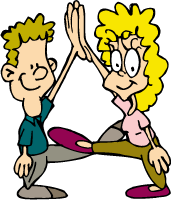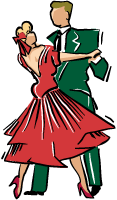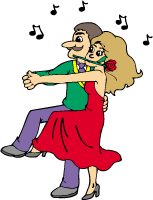Pointers On Leading And Following
 Your dance instructor should teach you not only the steps to each dance figure,
but also how to lead or follow your partner. Here's some advice on technique
for leading and following. If a point is unclear, please consult your teacher.
Your dance instructor should teach you not only the steps to each dance figure,
but also how to lead or follow your partner. Here's some advice on technique
for leading and following. If a point is unclear, please consult your teacher.
Leaders And Followers
- Don't clench your partner's hand, arm, or shoulder in a grip of death--a very light hold will suffice. Most turns are led with fingertip or palm contact. Execute push motions with your palm or fingers, and execute pull motions with hooked fingers. Leaders: if you need to pull your partner's hand toward you, just hook a few of your fingers into the curled fingers of her hand. Followers: in dances that are led hand-to-hand, keep your hands accessible.
- I'll repeat: don't squeeze your partner's hand with your thumb or fingers.
- Dance with your body, not from your feet. Hold your partner with your hand flat, L-shaped, or-- if holding a bony body part like a shoulder blade or hipbone--very gently curved. Keep your fingers together, and do not poke your partner or dig your fingers into your partner's back or side.
- Since you will always find your feet at the bottom of your legs, you're unlikely to learn anything useful by looking down. Instead, watch your partner. This is especially important for followers, since some leads have visual components.
- Maintain good frame. In some dances, particularly the Latin ones, you signal motion to your partner solely through the frame in your arms. Your arms should be held neither rigid nor limp--they are springs. Gently use the muscles in your arms to communicate tension and compression as needed. Pushing or pulling hard can make you feel uncomfortably heavy to your partner.
- Lead and follow are greatly enhanced by proper body shaping, rise and fall, and use of contra-body motion and contra-body motion position. These are best learned from professional instructors.
- When dancing socially, accommodate your partner. If your partner loses balance, arrives somewhere unexpected, or winds up on the wrong foot, do your best to complete the figure gracefully by adapting to your partner's actions. Sometimes this means gently bringing your partner back into place; at other times, you should travel to catch up to your partner.
- A special note about extemporaneous foot changes, or "fakes." You may occasionally find that you are on the wrong foot, or that your partner is on the wrong foot, and wish to fake a step to get back into sync with your partner. When this happens, I suggest that the follower give the leader at least one measure of music to adapt his feet to hers. If he doesn't notice, then she can adapt her feet to his. If you both "fake" at the same time, one of you will still be on the wrong foot!
- Remember that one of your goals in social dancing is to make your partner happy, and act accordingly.
Leaders
 Lead by moving your body and by gently signalling turns with palm or fingertip
contact.
Lead by moving your body and by gently signalling turns with palm or fingertip
contact.
- Do not push the follower around.
- Lead beginning followers with two hands rather than one where possible and appropriate. It will make your lead much clearer.
- In closed frame, gently cup your right hand on the bottom or middle of her left shoulder blade. Don't press your fingers into her back!
- In open position (i.e., when connected with extended arms, rather than in closed frame), joined hands should be held close to the waist level of the shorter partner. Typically, the leader lowers his hand to the follower's waist level. This makes the hold comfortable for both partners--otherwise, the follower would have to elevate her extended arm, which gets tiring.
- At the start of the dance, shift your weight right or left to put the follower's weight over her appropriate foot. For example, if you are starting a dance in which you first step with your left foot, shift your weight over your right foot, leaving your left foot free. Your connection with your partner will shift her weight over her left foot, freeing her right foot to move.
- Do not lead your partner through figures that give her great difficulty. If your partner misses a figure that you lead, it's not a bad idea to try it again--the second time is often the charm-- but don't keep leading her through it repeatedly unless she asks you to do so. That is, adapt the complexity of your figures to the level that makes her comfortable.
Followers
- Follow the leader's weight changes and/or rise & fall--these communicate his timing. When dancing socially, it won't matter if the leader is out of sync with the music so long as you follow his timing as conveyed by his motions.
- Wait for the leader to move before you do. The lead and follow will break down if you get ahead of him.
- You are self-propelled. The leader indicates where you are to go, but he doesn't put you there.
- A useful oversimplification of following is that you go when his body goes and where his body goes. However, there are dance figures in which you follow the motion of a part of the leader's body, such as his arm, rather than the motion of his whole body, which may be staying in place. One example would be the hockey stick in International Rumba.
- Support your own weight at all times--your partner is not a leaning post! It is particularly important to support yourself fully during a dip, because any weight that you place on your partner during this figure will be carried by his back. Remember that old adage: lift with the legs, not with the back!
- Take care not to dance solo syncopations to the point where your partner can no longer comfortably lead you. Ideally, your syncopations should not affect your movement together as a couple. Unfortunately, an imperfectly-performed syncopation can place you somewhere unexpected, disturb your partner's balance, or break your connection. Even perfectly-executed syncopations can be troublesome if you confuse your partner by performing more of them than he can handle. (Remember that his lead will break down if he winds up behind you in timing.) In dances like West Coast Swing and Lindy Hop, some followers get syncopation-happy and reduce the leader's role to that of a balance bar. This can be no fun at all for their partners. Thus, it's wise to limit the extent of your syncopations to the comfort level of your partner. If he looks unhappy, tone it down.
The Essence of Leading and Following
It takes instruction and practice to learn to how dance steps well. However, the essence of leading and following the figures is simple. To paraphrase the advice given by the King of Hearts to the White Rabbit--"begin at the beginning; go on till you come to the end; then stop"--the follower begins to move when led to move, and stops when led to stop. That is, the follower neither starts nor stops on her own. The leader must signal the motion of his body to the follower, while the follower feels and watches the motion of the leader's body (not of his feet!) for direction.
Further Reading
You can find more information (and other people's opinions) on leading and following in the extensive Lead and Follow FAQ compiled from internet contributors.